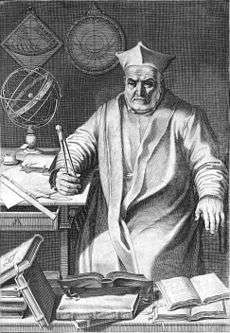Solar eclipse of August 21, 1560
| Solar eclipse of August 21, 1560 | |
|---|---|
 Map | |
| Type of eclipse | |
| Nature | Total |
| Gamma | 0.405 |
| Magnitude | 1.0469 |
| Maximum eclipse | |
| Duration | 225 sec (3 m 45 s) |
| Coordinates | 29°42′N 5°18′E / 29.7°N 5.3°E |
| Max. width of band | 170 km (110 mi) |
| Times (UTC) | |
| Greatest eclipse | 12:30:55 |
| References | |
| Saros | 118 (43 of 72) |
| Catalog # (SE5000) | 8451 |
A total solar eclipse occurred on August 21, 1560. A solar eclipse occurs when the Moon passes between Earth and the Sun, thereby totally or partly obscuring the image of the Sun for a viewer on Earth. A total solar eclipse occurs when the Moon's apparent diameter is larger than the Sun's, blocking all direct sunlight, turning day into darkness. Totality occurs in a narrow path across Earth's surface, with the partial solar eclipse visible over a surrounding region thousands of kilometres wide.
Observations
The prediction of this solar eclipse helped to inspire Tycho Brahe's (1546–1601) interest in astronomy at the age of 13.
The announcement of this forthcoming eclipse in France caused many Frenchmen to panic, fighting one another to be next in line at the confessional. One beleaguered parish priest tried to calm the populace by announcing that since there were so many waiting to confess, a decision had been made to postpone the eclipse for two weeks.[1]
Christopher Clavius, wrote (In Sphaeram Ioannis de Sacro Bosco Commentarius published in 1593) "I shall cite two remarkable eclipses of the Sun, which happened in my own time and thus not long ago. One of these I observed about midday at Coimbra in Lusitania (Portugal) in the year 1559 [sic], in which the Moon was placed between my sight and the Sun with the result that it covered the whole Sun for a considerable length of time. There was darkness in some manner greater than night; neither could one see where one stepped. Stars appeared in the sky and (marvellous to behold) the birds fell down from the sky to the ground in terror of such horrid darkness." [2]
Related eclipses
It is a part of solar Saros 118.
Notes
- ↑ SOLAR ECLIPSES IN HISTORY by Ken Poshedly
- ↑ Christopher Clavius
References
| Wikimedia Commons has media related to Solar eclipse of 1560 August 21. |

